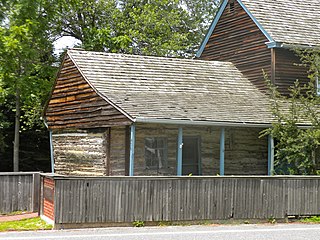Province of East Jersey | |||||||||||
|---|---|---|---|---|---|---|---|---|---|---|---|
| 1674–1702 | |||||||||||
Flag | |||||||||||
 The original provinces of West and East Jersey are shown in yellow and green, respectively. The Keith Line is shown in red, and the Coxe–Barclay Line is shown in orange. | |||||||||||
| Status | Colony of Kingdom of England | ||||||||||
| Capital | Perth Amboy | ||||||||||
| Common languages | English, Dutch | ||||||||||
| Religion | Puritanism | ||||||||||
| Government | Proprietary colony | ||||||||||
| Lord Proprietor | |||||||||||
• 1674-1680 | Sir George Carteret (initial) | ||||||||||
| Governor | |||||||||||
• 1674–1682 | Philip Carteret (first) | ||||||||||
• 1699–1702 | Andrew Hamilton (last) | ||||||||||
| History | |||||||||||
• Established | 1674 | ||||||||||
• Disestablished | 1702 | ||||||||||
| |||||||||||
The Province of East Jersey, along with the Province of West Jersey, between 1674 and 1702 in accordance with the Quintipartite Deed, were two distinct political divisions of the Province of New Jersey, which became the U.S. state of New Jersey. The two provinces were amalgamated in 1702. East Jersey's capital was located at Perth Amboy. Determination of an exact location for a border between West Jersey and East Jersey was often a matter of dispute.
Contents
- Constitution
- Governors of East Jersey (1674–1702)
- See also
- References
- Further reading
- External links
The area comprising East Jersey had been part of New Netherland. Early settlement (including today's Bergen and Hudson counties) by the Dutch included Pavonia (1633), Vriessendael (1640) and Achter Kol (1642). These settlements were compromised in Kieft's War (1643–1645) and the Peach War (1655). Settlers again returned to the western shores of the Hudson River with the 1660 formation of Bergen, New Netherland, which would become the first permanent European settlement in the territory of the modern state of New Jersey. During the Second Anglo-Dutch War, on August 27, 1664, New Amsterdam surrendered to English forces. [1]
Between 1664 and 1674, most settlement was from other parts of the Americas, especially New England, Long Island, and the West Indies. Elizabethtown and Newark in particular had a strong Puritan character. South of the Raritan River the Monmouth Tract was developed primarily by Quakers from Long Island. In 1675, East Jersey was partitioned into four counties for administrative purposes: Bergen County, Essex County, Middlesex County, and Monmouth County. There were seven established towns: Shrewsbury, Middleton, Piscataway, Woodbridge, Elizabethtown, Newark, and Bergen. In a survey taken in 1684, the population was estimated to be 3,500 individuals in about 700 families (African slaves were not included).
Although a number of the East Jersey proprietors in England were Quakers and the governor through most of the 1680s was the leading Quaker Robert Barclay, the Quaker influence on government was not significant. Even the immigration instigated by Barclay was oriented toward promoting Scottish influence more than Quaker influence. In 1682, Barclay and the other Scottish proprietors began the development of Perth Amboy as the capital of the province. In 1687, James II permitted ships to be cleared at Perth Amboy. [2]
Frequent disputes between the residents and the mostly-absentee proprietors over land ownership and quitrents plagued the province until its surrender to Queen Anne's government in 1702.
| Date | Boundary Name | Description |
| 1674 | Original Duke of York Line (did not recognize John Fenwick's holdings) | Barnegat Bay to Rancocas Creek on the Delaware River just north of present-day Philadelphia. |
| 1676 | Quintipartite Deed Line (between George Carteret on the East, and William Penn, Gawen Lawrie, Nicholas Lucas, and Edward Byllynge on the West, except for 10% to John Fenwick) | On the north from a point 41° 40' latitude on the Delaware River extending southward on a straight and direct line to the east side of Little Egg Harbor. |
| 1687 | William Emley / John Reid Adjustment (commissioners from West and East Jersey respectively) | Adjusted description on the Delaware fifty minutes more westerly due to magnetic compass variation |
| 1687 | Keith Line aka Province Line (Surveyed north only to the south branch of the Raritan River) | Stopped by Governor Daniel Coxe of West Jersey and Governor Robert Barclay of East Jersey |
| 1688 | Coxe-Barclay Line Survey | Extended the Keith Line from the Raritan River along specific properties that defined the eastern boundaries of present- day Morris and Sussex Counties and the northern border of Somerset County |
| 1696 | Thornton Line Survey | Attempted to correct errors from previous surveys |
| 1702 | East and West Jersey United | Violence became so obsessive, that East and West proprietors gave up their individual governing rights to Queen Anne |
| 1743 | Lawrence Line Survey (Land ownership disputes continued. West Jersey proprietors attempted to fund survey but failed. East Jersey Proprietors then hired John Lawrence) | Adopted by NJ supreme court in 1855 as the final arbiter of all land disputes. Today defines boundary for Walpack, Sandyston, Stillwater, Hampton, and Green Townships |











